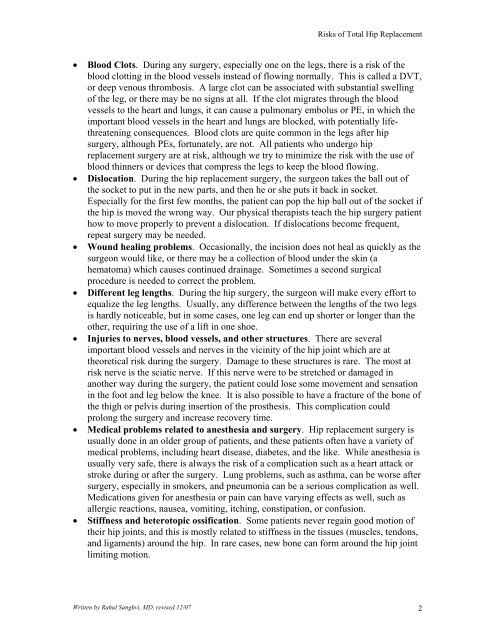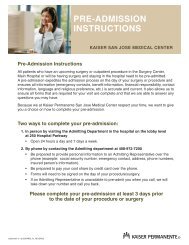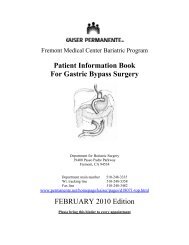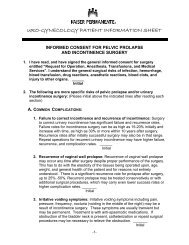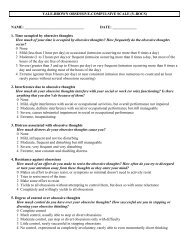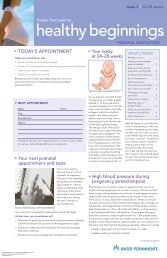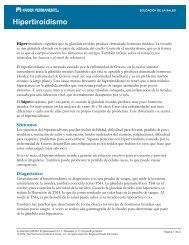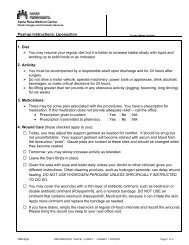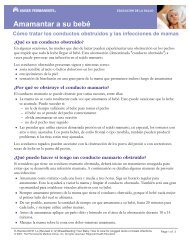Risks of Surgery: Total Hip Replacement - permanente.net
Risks of Surgery: Total Hip Replacement - permanente.net
Risks of Surgery: Total Hip Replacement - permanente.net
Create successful ePaper yourself
Turn your PDF publications into a flip-book with our unique Google optimized e-Paper software.
<strong>Risks</strong> <strong>of</strong> <strong>Total</strong> <strong>Hip</strong> <strong>Replacement</strong><br />
• Blood Clots. During any surgery, especially one on the legs, there is a risk <strong>of</strong> the<br />
blood clotting in the blood vessels instead <strong>of</strong> flowing normally. This is called a DVT,<br />
or deep venous thrombosis. A large clot can be associated with substantial swelling<br />
<strong>of</strong> the leg, or there may be no signs at all. If the clot migrates through the blood<br />
vessels to the heart and lungs, it can cause a pulmonary embolus or PE, in which the<br />
important blood vessels in the heart and lungs are blocked, with potentially lifethreatening<br />
consequences. Blood clots are quite common in the legs after hip<br />
surgery, although PEs, fortunately, are not. All patients who undergo hip<br />
replacement surgery are at risk, although we try to minimize the risk with the use <strong>of</strong><br />
blood thinners or devices that compress the legs to keep the blood flowing.<br />
• Dislocation. During the hip replacement surgery, the surgeon takes the ball out <strong>of</strong><br />
the socket to put in the new parts, and then he or she puts it back in socket.<br />
Especially for the first few months, the patient can pop the hip ball out <strong>of</strong> the socket if<br />
the hip is moved the wrong way. Our physical therapists teach the hip surgery patient<br />
how to move properly to prevent a dislocation. If dislocations become frequent,<br />
repeat surgery may be needed.<br />
• Wound healing problems. Occasionally, the incision does not heal as quickly as the<br />
surgeon would like, or there may be a collection <strong>of</strong> blood under the skin (a<br />
hematoma) which causes continued drainage. Sometimes a second surgical<br />
procedure is needed to correct the problem.<br />
• Different leg lengths. During the hip surgery, the surgeon will make every effort to<br />
equalize the leg lengths. Usually, any difference between the lengths <strong>of</strong> the two legs<br />
is hardly noticeable, but in some cases, one leg can end up shorter or longer than the<br />
other, requiring the use <strong>of</strong> a lift in one shoe.<br />
• Injuries to nerves, blood vessels, and other structures. There are several<br />
important blood vessels and nerves in the vicinity <strong>of</strong> the hip joint which are at<br />
theoretical risk during the surgery. Damage to these structures is rare. The most at<br />
risk nerve is the sciatic nerve. If this nerve were to be stretched or damaged in<br />
another way during the surgery, the patient could lose some movement and sensation<br />
in the foot and leg below the knee. It is also possible to have a fracture <strong>of</strong> the bone <strong>of</strong><br />
the thigh or pelvis during insertion <strong>of</strong> the prosthesis. This complication could<br />
prolong the surgery and increase recovery time.<br />
• Medical problems related to anesthesia and surgery. <strong>Hip</strong> replacement surgery is<br />
usually done in an older group <strong>of</strong> patients, and these patients <strong>of</strong>ten have a variety <strong>of</strong><br />
medical problems, including heart disease, diabetes, and the like. While anesthesia is<br />
usually very safe, there is always the risk <strong>of</strong> a complication such as a heart attack or<br />
stroke during or after the surgery. Lung problems, such as asthma, can be worse after<br />
surgery, especially in smokers, and pneumonia can be a serious complication as well.<br />
Medications given for anesthesia or pain can have varying effects as well, such as<br />
allergic reactions, nausea, vomiting, itching, constipation, or confusion.<br />
• Stiffness and heterotopic ossification. Some patients never regain good motion <strong>of</strong><br />
their hip joints, and this is mostly related to stiffness in the tissues (muscles, tendons,<br />
and ligaments) around the hip. In rare cases, new bone can form around the hip joint<br />
limiting motion.<br />
Written by Rahul Sanghvi, MD, revised 12/07 2


